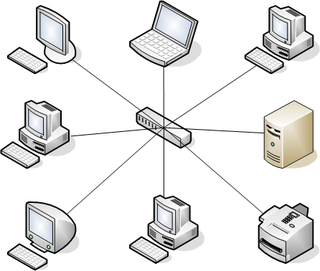Loading AI tools
Computer network topology From Wikipedia, the free encyclopedia
A star network is an implementation of a spoke–hub distribution paradigm in computer networks. In a star network, every host is connected to a central hub. In its simplest form, one central hub acts as a conduit to transmit messages.[1] The star network is one of the most common computer network topologies.

The hub and hosts, and the transmission lines between them, form a graph with the topology of a star. Data on a star network passes through the hub before continuing to its destination. The hub manages and controls all functions of the network. It also acts as a repeater for the data flow. In a typical network the hub can be a network switch, ethernet hub, wireless access point or a router
The star topology reduces the impact of a transmission line failure by independently connecting each host to the hub. Each host may thus communicate with all others by transmitting to, and receiving from, the hub. The failure of a transmission line linking any host to the hub will result in the isolation of that host from all others, but the rest of the network will be unaffected.[2]
The star configuration is commonly used with twisted pair cable and optical fiber cable. However, it can also be used with coaxial cable as in, for example, a video router.
Seamless Wikipedia browsing. On steroids.
Every time you click a link to Wikipedia, Wiktionary or Wikiquote in your browser's search results, it will show the modern Wikiwand interface.
Wikiwand extension is a five stars, simple, with minimum permission required to keep your browsing private, safe and transparent.